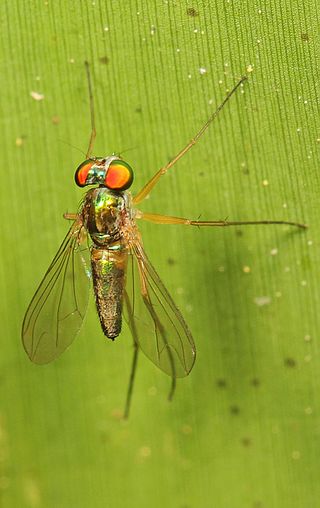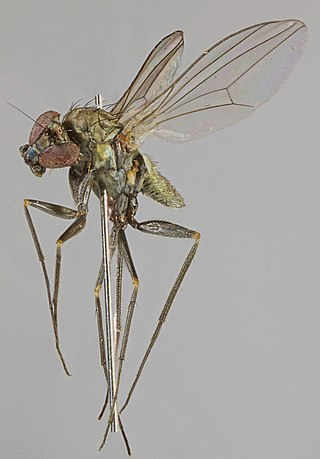
Dolichopodidae, the long-legged flies, are a large, cosmopolitan family of true flies with more than 8,000 described species in about 250 genera. The genus Dolichopus is the most speciose, with some 600 species.
Acropsilus is a genus of flies in the family Dolichopodidae. It is unplaced in the family, having been placed variously in subfamilies such as Sympycninae or Peloropeodinae. It is superficially similar to the Medeterinae.

Amblypsilopus is a genus of flies in the family Dolichopodidae. It is a large genus, with about 350 species recorded. However, it is possibly polyphyletic.
Chaetogonopteron is a genus of flies in the family Dolichopodidae.

Chrysosoma is a genus of flies in the family Dolichopodidae. It is a large genus, with more than 200 species distributed in the Old World and Oceania.
Dolichophorus is a genus of flies in the family Dolichopodidae. It includes eight species distributed in the Palaearctic and Afrotropical realms. The adults have a metallic green, green-black or blue-black body coloring, with some pruinescence.
Dytomyia is a genus of flies in the family Dolichopodidae. It is known from Australia, Madagascar and Kenya, with an undescribed species from Papua New Guinea.

Medetera is a large genus of flies in the family Dolichopodidae. It includes about 350 species worldwide. The adults are commonly found resting on vertical surfaces such as tree trunks, on which they have a characteristic vertical upright stance. Because of this stance, they are sometimes known as "woodpecker flies". Medetera adults are predators of soft-bodied arthropods, while the larvae are predators of bark beetle larvae.
Mesorhaga is a genus of flies in the family Dolichopodidae.
Saccopheronta is a genus of flies in the family Dolichopodidae. It is considered a synonym of Medetera by some authors, and a valid genus by others.
Systenus is a genus of flies in the family Dolichopodidae.

Medeterinae is a subfamily of flies in the family Dolichopodidae.

Peloropeodinae is a subfamily of flies in the family Dolichopodidae. In some classifications, the genera of the subfamily are included in Sympycninae. According to a molecular phylogenetic analysis of the family Dolichopodidae by Germann et al. (2011), the subfamily is polyphyletic.

Medetera truncorum is a species of fly in the family Dolichopodidae. It is widely distributed in the Western Palaearctic. It also occurs in the Pacific Northwest in North America, where it may be an introduced species.
Medetera bistriata is a species of longlegged fly in the family Dolichopodidae. It is widely distributed in North America, spanning from the pine forests of boreal Canada south to Honduras, and it is common in the pine forests of the Atlantic and Gulf costal plains. The larvae are predators of bark beetles in the genera Dendroctonus and Ips, and have been noted as important predators of the southern pine beetle, Dendroctonus frontalis.
Demetera is a genus of flies in the family Dolichopodidae. It contains eight species formerly included in Medetera in the M. melanesiana species group. The species are found in the Afrotropical, Oriental and Australasian regions. According to Naglis and Bickel (2012), it was unwarranted to establish a separate genus for this group of species.
Medetera arnaudi is a species of long-legged fly in the family Dolichopodidae. It is known from the Central Valley and Coast Ranges of California. It is named after the entomologist Paul H. Arnaud, Jr., who collected the type specimens.
Medetera aberrans is a species of long-legged fly in the family Dolichopodidae. It is distributed in Eastern North America. Adults of the species are generally colored a metallic green, with yellow legs. Not much is known about the biology of the species, but adults have frequently been collected from wet grasslands or marshes.
Medetera apicalis is a species of long-legged fly in the family Dolichopodidae. It is found in Europe and North America. This species is more common in old-growth forest habitats, where it can be found beneath bark or on the fruiting bodies of wood-decaying fungi such as Fomitopsis pinicola.





